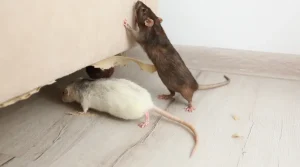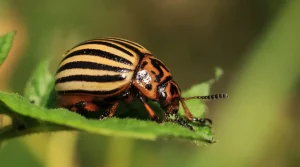At an annual cost of over $5 billion, termites are the pest that causes the most property damage in the United States. We want to provide you with some advice on what to check for in your home if you suspect termites so that you can help stop your home from becoming one of that alarming number.
What Kind of Pest Are Termites?
The termite itself is, of course, the best indicator of a termite infestation. Although everyone has heard of termites, many people might not be completely familiar with their appearance. While trying to self-diagnose a termite issue, there are a few crucial factors to keep in mind that are sometimes mistaken for ants, such as:
- Termites frequently have a lighter appearance than ants, ranging from a creamy white to a brownish hue, as opposed to the darker browns and blacks that are typical of ants.
- Size – Termites typically measure 1/8 to 1 inch in length. The queen of a colony is obviously considerably larger, growing up to 6 inches in size with her enormous belly. Of fact, this describes the size of the most frequent caste of termites.
- The most obvious change can be found in body shape. In contrast to ants, which have tight waists, termites have thicker waists. In addition, they are smaller than ants and have straight antennae rather than curved ones.
- Wings: Termites don’t typically have wings, but when they do, they will have two pairs of wings that are each the same length. Ants have wing pairs with various lengths.
What Kinds Of Termite Varieties Exist?
In spite of the fact that there are about 45 different species of termites in the United States, they typically fall into one of three groups. Their classification primarily depends on how they seem, where they build their nests, and how they behave. Termites can be classified into three main categories:
Termites in the ground
Subterranean termites, the type of termite that is most prevalent, make their nests in soils all throughout the U.S. continent. As the largest nest builders among all termite species, they are also the main culprits for homes and other property damage. To get to their source of food, the tasty wood of your home, these termites will dig mud tubes under your yard.
Dried-wood termites
As their name implies, dry wood termites prefer to establish colonies in dead or decaying dry wood, such as dead trees, structural beams, or solid hardwood flooring. You should search for them on and around your property because they will go to great lengths to avoid dirt. While being often larger than their underground cousins, they, fortunately, have fewer colonies, which means that they generally wreak harm at a slower rate. Of course, this does not imply that your home is no longer seriously threatened by them.
Termites from Formosa
Among all termites, Formosan termites pose the greatest threat. Due to the extensive connections between their nest and their food source, they are extremely challenging to eradicate once embedded. They can even temporarily establish themselves in high-food locations, such as your home, but the main nest will still be there even if you remove any nests there.
Have Termites Had Wings?
Yes, termites do have wings, which is a straightforward response. Before you start picturing swarms of flying termites destroying your house, it’s crucial to understand that only a few castes of termites have wings, and even then, they can only fly during particular seasons of the year. Alate nymphs, often known as termite swarmers, are the only termite caste with wings in a colony.
Termite infestation warning signs
Fortunately, considering the amount of damage that termites can produce, it is rather simple to notice indications of a serious termite infestation provided you know what to look for. Termite infestations most frequently show the following symptoms:
- As you cross the hollowed-out wood, you might be able to hear a sound.
- Wooden flooring bubbles – Little bubbles on your floor.
- These will resemble coffee grounds. Pellets or droppings.
- They resemble ants in size, whether their bodies are wings.
- Mud tubes are tubes that you could discover outside or in your crawl area.
Termites: Are They Hazardous to People?
Termites may be a serious threat to your house, but they don’t pose much of a threat to you or your loved ones until they cause the house to collapse on top of you. They don’t appear to want to bite or sting people unless provoked, and they don’t carry any known dangerous diseases that could be spread.
What Pulls Termites Into My Home?
The main thing that termites are looking for is a food supply, just as many other insects. Considering that their main source of food is wood, dwellings appear to be very appetizing to them. Moisture attracts termites as well. Wood that has moisture, damp areas inside the house, and any outside fractures. Although termites enjoy warm weather, spring, early summer, and fall are the times of year when you are most likely to encounter termites. It is simple to understand why the south is the United States’ termite hotspot when heat and humidity are combined.
How to stop termites
Termite prevention is usually preferable to termite extermination because it is ultimately considerably less expensive. Leading preventative measures for termites include:
- Keep outdoor plants away from your house, including tree branches. Subterranean termite transfer from your yard to your home can be avoided by making sure that no vegetation or foliage is in direct touch with the structure.
- Maintain the dryness of your foundations, whether they are made of wood, concrete, crawl spaces, or another material. You should look for any persistent damp places to find any potential moisture problems following any periods of severe rain or flash flooding.
- Regularly remove all yard waste – Make sure that any yard waste, such as mulch and fallen leaves, is maintained far from the house. Make sure you frequently clean your gutters as part of this.
- Look out for flying termites during the swarming season. Flying termites are the breeders, therefore it’s important to keep them away from your home. If you start to see them flying, keep your windows closed, turn off the lights at night, and check your house for any gaps.
Termite Removal Techniques
If you’ve read thus far, it’s probable that you already know a lot of this information and only need to know how to remove those annoying termites from your house. There are a few things you can do on your own, however, we would clearly advise hiring an expert because the house might already have significant termite damage.
- Termite products – Despite their varying levels of efficacy, the many termite removal products available on the market will all contribute to the eradication of termites. You primarily have two product choices: spot treatments and bait treatments.
- Beneficial nematodes – These tiny roundworms are parasites of termites and will quickly kill them within a few days. They are a more natural remedy for termites.
- Essential oils – Certain essential oils, such as neem oil and orange oil, can assist to kill off termites in a number of ways, including by stopping their egg-laying or shedding cycles.
- Boric acid – Because it shuts down the termites’ whole system, boric acid is a well-known way for destroying them.
You should now be able to recognize any termites and prevent a termite infestation in your home. For all of your termite removal needs, as usual, we advise you to contact the experts at thousand-oaks-pest-control.com.




